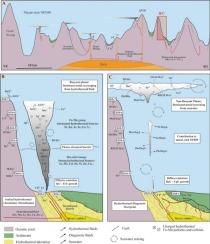热液、海水和成岩流体的相互作用是Cocos-Nazca扩张中心锰铁地壳中锂和临界金属富集的主要驱动因素
IF 3.6
2区 地球科学
Q1 GEOLOGY
引用次数: 0
摘要
锰铁结壳(Fe-Mn结壳)因其经济潜力而具有重要意义。然而,东赤道太平洋的热液地壳作为资源目标仍未得到充分研究。本研究利用整体地球化学和微结构矿物学分析技术,对Cocos-Nazca扩张中心离轴、断层控制的热液系统中的7个Fe-Mn地壳样品进行了评估。结果表明,铁锰地壳存在明显的热液-成氢连续统,受热液-成氢连续统的影响。近端Fe-Mn地壳表现出明显的热液特征:Mn升高(高达35%);7-10 Å锰酸盐优势度;快速生长速率(>878 mm/Ma);水热衍生金属含量高(Li高达607µg/g, Ni ~ 0.35 wt%, Cu和Zn ~ 0.22 wt%)。相反,远端地壳表现出减弱的热液特征,氢源金属浓度增加(497µg/g Co, 620µg/g ΣREY),中高镍、铜和锌浓度主要被铁氧氢氧化物和铁vernadite清除。层控基质反映热液-成岩交替作用,但只有纯热液矿物贫金属或富锌,而受成岩作用影响的层显示出显著的Ni-Cu富集。微量金属的分布模式表明,有效和选择性的金属清除是由所涉及的流体类型控制的,但金属浓度受环境因素(例如金属溶解度、铁或锰氧化物的沉淀、温度和到排气口的距离)的调节。喷口喷出的热液柱颗粒和胶体有效地从热液流体和海水中清除了Fe-Mn地壳中的金属,而热液循环对沉积物金属的再活化则驱动了层控矿化对Ni-Cu的富集。丰富的多金属热液地壳主要是通过热液、海水和成岩流体的相互作用形成的,而不是单纯的热液流体。类似的铁锰结壳以及东赤道太平洋的其他矿床突出了该地区未被勘探但具有重要的资源潜力。本文章由计算机程序翻译,如有差异,请以英文原文为准。

Interplay of hydrothermal, seawater, and diagenetic fluids as principal driver of lithium and critical‑metal enrichment in the Cocos-Nazca spreading center ferromanganese crusts
Ferromanganese crusts (Fe-Mn crusts) are of significant importance due to their economic potential. However, hydrothermal crusts from the Eastern Equatorial Pacific have remained understudied as resource targets. This work evaluates seven Fe-Mn crust samples from an off-axis, fault-controlled hydrothermal system at the Cocos-Nazca Spreading Center using bulk geochemical and micro-textural mineralogical analyses techniques. The results indicate a clear hydrothermal-hydrogenetic formation continuum influenced by vent proximity for the Fe-Mn crusts. Proximal Fe-Mn crusts exhibit pronounced hydrothermal signatures: elevated Mn (up to 35 %); dominance of 7–10 Å manganates; fast growth rates (>878 mm/Ma); and high contents of hydrothermally derived metals (Li up to 607 µg/g, Ni ∼ 0.35 wt%, Cu and Zn ∼ 0.22 wt%). Distal crusts, conversely, exhibit attenuated hydrothermal features, increased hydrogenetic metal concentrations (497 µg/g Co, 620 µg/g ΣREY), and high-moderate Ni, Cu and Zn concentrations scavenged predominantly by Fe-oxyhydroxides and Fe-vernadite. Stratabound substrates reflect alternating hydrothermal-diagenetic influences, however only purely hydrothermal minerals are either metal-poor or Zn-rich, whereas diagenetically affected layers display notable Ni-Cu enrichments. Trace metal distribution patterns suggest that effective and selective metal scavenging is controlled by the types of fluids involved, but metal concentrations are regulated by environmental factors (e.g. metal solubility, precipitation of Fe or Mn oxides, temperature and distance to vent). Hydrothermal plume particles and colloids emitted by the vent effectively scavenge metals from both hydrothermal fluids and seawater for the Fe-Mn crust, while sediment‑derived metal remobilization via hydrothermal circulation drives Ni-Cu enrichment on the stratabound mineralization. Significantly enriched polymetallic hydrothermal crusts form primarily through interactions among hydrothermal, seawater, and diagenetic fluids rather than hydrothermal fluids alone. Similar Fe-Mn crusts as well as other mineral deposits in the Eastern Equatorial Pacific highlight the underexplored but significant resource potential of this region.
求助全文
通过发布文献求助,成功后即可免费获取论文全文。
去求助
来源期刊

Ore Geology Reviews
地学-地质学
CiteScore
6.50
自引率
27.30%
发文量
546
审稿时长
22.9 weeks
期刊介绍:
Ore Geology Reviews aims to familiarize all earth scientists with recent advances in a number of interconnected disciplines related to the study of, and search for, ore deposits. The reviews range from brief to longer contributions, but the journal preferentially publishes manuscripts that fill the niche between the commonly shorter journal articles and the comprehensive book coverages, and thus has a special appeal to many authors and readers.
 求助内容:
求助内容: 应助结果提醒方式:
应助结果提醒方式:


